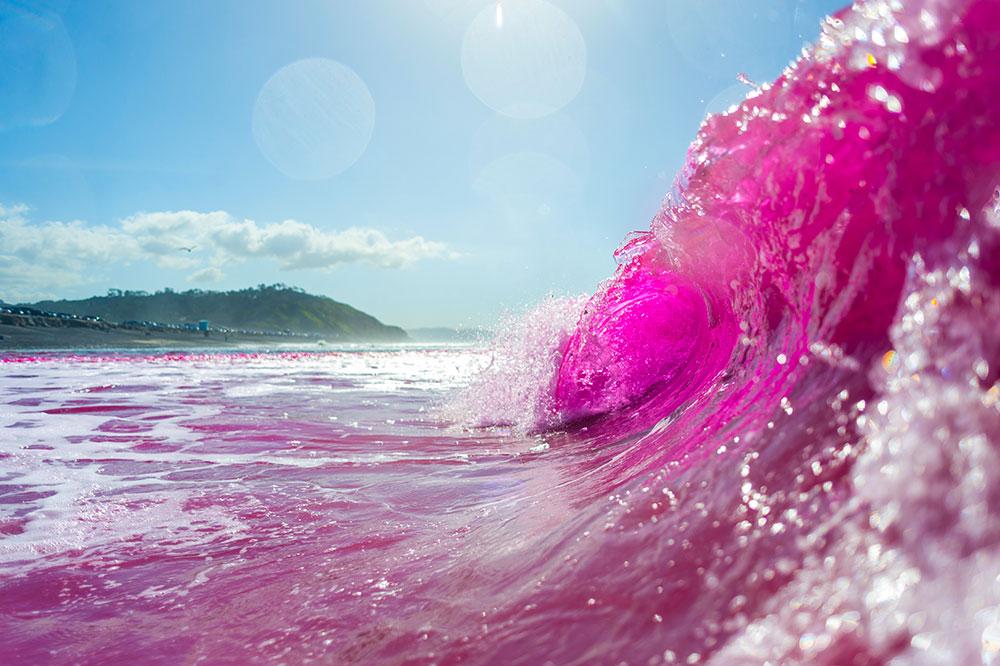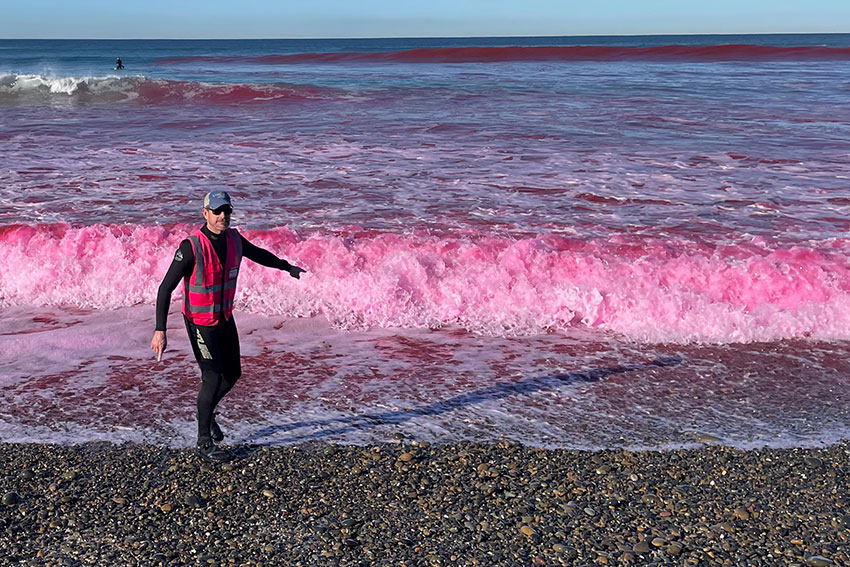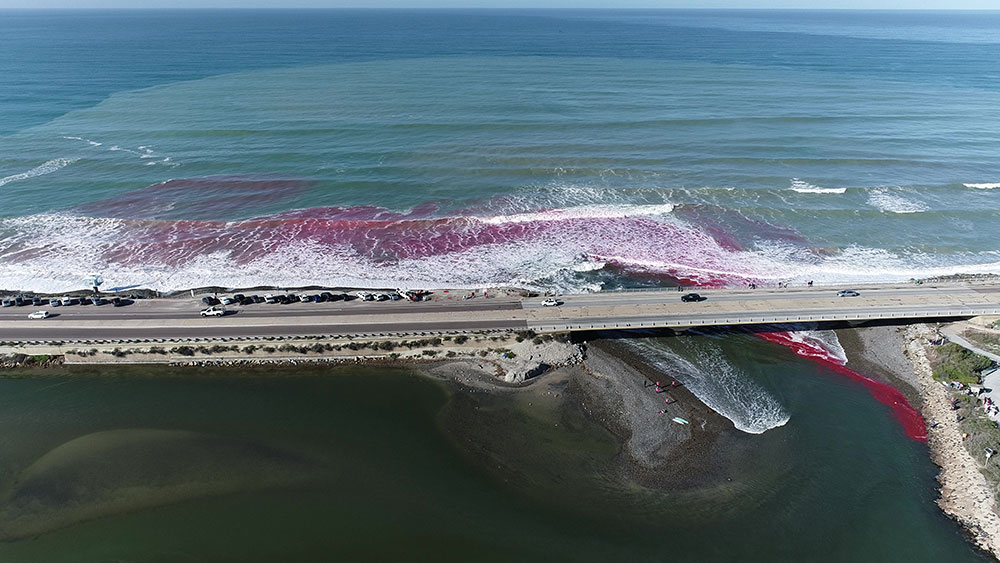By Brooke Fisher
Photo credits: Erik Jepsen/UC San Diego and UW researchers

The phrase “a splash of color” took on a very literal meaning for a team of researchers stationed at a beach in San Diego. Using environmentally safe pink dye, they are investigating the movement of water within a coastal zone, specifically where a river flows into the ocean.

CEE Professor Alex Horner-Devine steps out of the pink surf while tending to GPS drifters during the dye release.
“It’s bright pink — we need it to be that bright,” says CEE Professor Alex Horner-Devine about the nontoxic dye. “We have to start with something concentrated so that we can see it get diluted for a long enough time to observe all the processes that mix it.”
At the mouth of the Los Peñasquitos Lagoon estuary, where the freshwater river meets the ocean, the first of three dye releases kicked off on January 20. Although visible to the naked eye for only a few hours, smaller traces of dye can be detected with technology for up to 24 hours.
By investigating the water movement dynamics, the researchers hope to gain a better understanding of how various substances, especially pollutants, move from the nearshore area to outer waters. Specialized equipment is being employed to track both the movement and concentration of the pink dye, some of which has never been used before in this type of research.
“Instead of shooting out immediately, the pink dye was trapped at the coast by the waves,” Horner-Devine says about the team’s early observations. “The potential impact of pollutants is much higher because instead of being quickly diluted into the ocean, the freshwater is trapped in the nearshore region where people are swimming on the beach.”

APL scientist and CEE affiliate professor Morteza Derakhti and CEE Ph.D. student Yingzhong Lou, from left, map the elevation of the seabed of the river mouth at low tide using a GPS survey trolley.
To undertake the NSF-funded Plumes in Nearshore Conditions (PiNC) project, CEE researchers are collaborating with lead researchers at Scripps Institution of Oceanography in La Jolla, California. In addition to Horner-Devine, the CEE team includes Ph.D. student Yingzhong Lou and Applied Physics Laboratory scientist and CEE affiliate professor Morteza Derakhti. Also participating are CEE alumnus Raul Flores (Ph.D. ’18) and colleague Megan Williams, faculty at Universidad Técnica Federico Santa María in Chile, who are working on related research in Chilean rivers.
Going deeper: smaller rivers
Until now, previous studies have primarily focused on investigating the dynamics of how freshwater from large rivers mixes with saline seawater. The Los Peñasquitos Lagoon was therefore selected as an example of a smaller river discharging into the ocean where it forms a plume — the resulting combined water mass.
For more than three decades, researchers have been studying the fate of river water traveling into the ocean from big rivers, such as the Columbia, Mississippi and Hudson. However, this research isn’t directly transferrable to smaller rivers for several reasons. Larger river outflows generally don’t experience the impacts of big breaking waves because they are protected by jetties. In smaller rivers, wave breaking is thought to be important to the dispersion of freshwater. Also, the water quality of smaller rivers draining into the ocean is often not monitored as closely as that of larger rivers.
“The cumulative effect of many small rivers may be similar in terms of impact to a much larger river like the Columbia,” Horner-Devine says. “The rivers collect chemicals, nutrients and contaminants upstream in the watershed and transport them out to the coastal ocean, where they impact the marine ecosystem.”
Utilizing new technology
.jpg)
Drones with hyperspectral sensors are used to measure the concentration of pink dye from above.
Historically, river plumes have been studied by lowering instrumentation off the edge of boats, which isn’t feasible this close to the shoreline. In addition to a variety of sensors installed at various ocean depths that measure everything from salinity to turbulence, the researchers are employing two pieces of new technology: GPS-tracked drifting sensors that record the trajectory of the river water and drones equipped with hyperspectral sensing.
Used for the first time to study river dynamics, the hyperspectral sensors can measure the concentration of pink dye from overhead with a great degree of precision. To validate the measurements, a team of researchers is also utilizing jet skis fitted with fluorometers to calculate dye concentrations.
“The idea is to map out from the sky the distribution of river water based on dye concentration, so you can quantify how much river water has gone in a particular direction and also how much it has been diluted,” Horner-Devine says. “It’s a very difficult thing to measure; what has changed is being able to image it from above in a meaningful way.”
Modeling efforts
Following the data gathering, the CEE researchers will undertake further analysis and refine their computer models — which they hope will one day help manage coastal areas and prevent pollution events through enhanced prediction of dilution rates and transportation processes.
“One of the main challenges in field-scale modeling of nearshore mixing and transport processes is to use an appropriate model to represent unresolved turbulent mixing and transport,” Derakhti says. “The data will guide the development of efficient turbulent modeling when both wave breaking and river currents are interacting.”
As a graduate student, Lou has spent the past three years developing a generalizable computer model to help predict the movement of river water flowing into the surf zone. Since it can be difficult to tease apart the various dynamics in a realistic model, this type of model helps illustrate unique processes. While the model predicted the plume circulation patterns during the dye releases, Lou says there were some surprising observations.
“The most important thing we observed was some ejections of the river plume into the inner shelf. When plumes are trapped and move along the shore, some will eventually be injected into the inner shelf — this may be due to rip currents or eddy processes,” Lou says.
The edge of the surf zone is often considered to be a semi-permeable barrier since exchange between the surf zone and the rest of the ocean is limited. This research therefore contributes to the larger goal of identifying the processes that cross this boundary. At this point, the researchers’ hunch is that rather than waves alone, rip currents, which are powerful jets that cross the surf zone, may be involved in the transport process.
“One of the intriguing things about this research is that it falls between two disciplinary groups. For decades, people studying rivers always ignored waves and the people studying waves ignored rivers,” says Horner-Devine. “The intersection of the two is actually a new area — A lot is known about wave breaking and river plumes, but little is known about how they interact with each other.”

Dye is introduced into the estuary water (bottom right) immediately before it flows under the bridge and into the coastal ocean. Currents and turbulence generated by breaking waves trap the dyed river water in the surf zone and transport it alongshore.
Originally published February 1, 2023